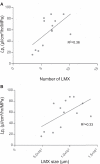Natural variation of maize root hydraulic architecture underlies highly diverse water uptake capacities
- PMID: 37052178
- PMCID: PMC10315320
- DOI: 10.1093/plphys/kiad213
Natural variation of maize root hydraulic architecture underlies highly diverse water uptake capacities
Abstract
Plant water uptake is determined by the root system architecture and its hydraulic capacity, which together define the root hydraulic architecture. The current research aims at understanding the water uptake capacities of maize (Zea mays), a model organism and major crop. We explored the genetic variations within a collection of 224 maize inbred Dent lines and successively defined core genotype subsets to access multiple architectural, anatomical, and hydraulic parameters in the primary root (PR) and seminal roots (SR) of hydroponically grown seedlings. We found 9-, 3.5-, and 12.4-fold genotypic differences for root hydraulics (Lpr), PR size, and lateral root size, respectively, that shaped wide and independent variations of root structure and function. Within genotypes, PR and SR showed similarities in hydraulics and, to a lesser extent, in anatomy. They had comparable aquaporin activity profiles that, however, could not be explained by aquaporin expression levels. Genotypic variations in the size and number of late meta xylem vessels were positively correlated with Lpr. Inverse modeling further revealed dramatic genotypic differences in the xylem conductance profile. Thus, tremendous natural variation of maize root hydraulic architecture underlies a high diversity of water uptake strategies and paves the way to quantitative genetic dissection of its elementary traits.
© The Author(s) 2023. Published by Oxford University Press on behalf of American Society of Plant Biologists.
Conflict of interest statement
Conflict of interest statement. None declared. All authors have approved the final article.
Figures







Similar articles
-
The Dynamics of Cell-to-Cell Water Transport and the Involvement of Aquaporins in Response to Apoplast Blockage in the Roots of Intact Maize Plants.Cells. 2025 Jun 14;14(12):902. doi: 10.3390/cells14120902. Cells. 2025. PMID: 40558529 Free PMC article.
-
The transcription factors DOF4.6 and XND1 jointly regulate root hydraulics and drought responses in Arabidopsis.Plant Cell. 2025 Apr 2;37(4):koaf083. doi: 10.1093/plcell/koaf083. Plant Cell. 2025. PMID: 40262770
-
The role of maize (Zea mays L.) radicle root hairs in seedling establishment under adverse phosphorus and water seedbed conditions.Ann Bot. 2025 Jul 9:mcaf142. doi: 10.1093/aob/mcaf142. Online ahead of print. Ann Bot. 2025. PMID: 40632906
-
Clinical symptoms, signs and tests for identification of impending and current water-loss dehydration in older people.Cochrane Database Syst Rev. 2015 Apr 30;2015(4):CD009647. doi: 10.1002/14651858.CD009647.pub2. Cochrane Database Syst Rev. 2015. PMID: 25924806 Free PMC article.
-
Signs and symptoms to determine if a patient presenting in primary care or hospital outpatient settings has COVID-19.Cochrane Database Syst Rev. 2022 May 20;5(5):CD013665. doi: 10.1002/14651858.CD013665.pub3. Cochrane Database Syst Rev. 2022. PMID: 35593186 Free PMC article.
Cited by
-
Field plants strategically regulate water uptake from different soil depths by spatiotemporally adjusting their radial root hydraulic conductivity.New Phytol. 2025 Jul;247(2):546-561. doi: 10.1111/nph.70013. Epub 2025 Mar 19. New Phytol. 2025. PMID: 40104889 Free PMC article.
-
Genetic variability of aquaporin expression in maize: From eQTLs to a MITE insertion regulating PIP2;5 expression.Plant Physiol. 2024 Sep 2;196(1):368-384. doi: 10.1093/plphys/kiae326. Plant Physiol. 2024. PMID: 38839061 Free PMC article.
-
Root hydraulic properties: An exploration of their variability across scales.Plant Direct. 2024 Apr 7;8(4):e582. doi: 10.1002/pld3.582. eCollection 2024 Apr. Plant Direct. 2024. PMID: 38590783 Free PMC article. Review.
-
A maize landrace introgression library reveals a negative effect of root-to-shoot ratio on water-use efficiency.Plant Genome. 2025 Jun;18(2):e70036. doi: 10.1002/tpg2.70036. Plant Genome. 2025. PMID: 40281664 Free PMC article.
-
Primary, seminal and lateral roots of maize show type-specific growth and hydraulic responses to water deficit.Plant Physiol. 2024 Mar 29;194(4):2564-2579. doi: 10.1093/plphys/kiad675. Plant Physiol. 2024. PMID: 38217868 Free PMC article.
References
-
- Ahmed MA, Zarebanadkouki M, Kaestner A, Carminati A. Measurements of water uptake of maize roots: the key function of lateral roots. Plant Soil. 2016:398(1–2):59–77. 10.1007/s11104-015-2639-6 - DOI
Publication types
MeSH terms
Substances
LinkOut - more resources
Full Text Sources
Research Materials

